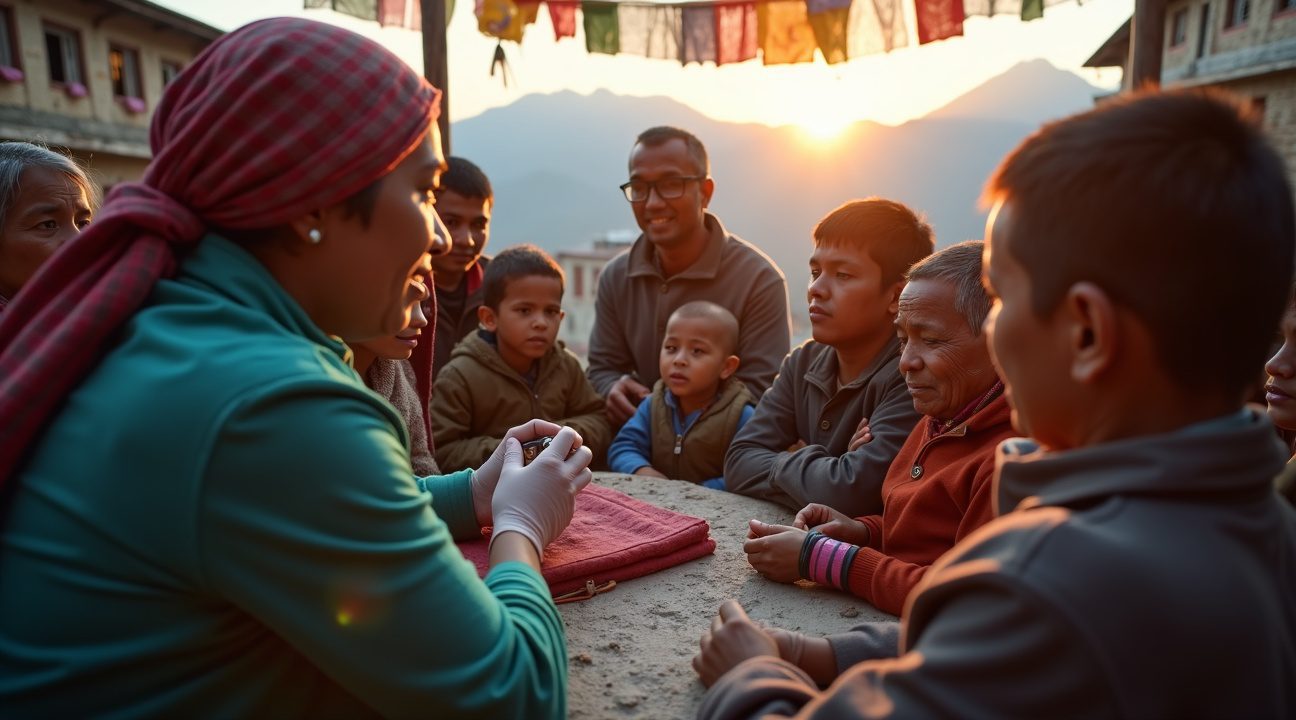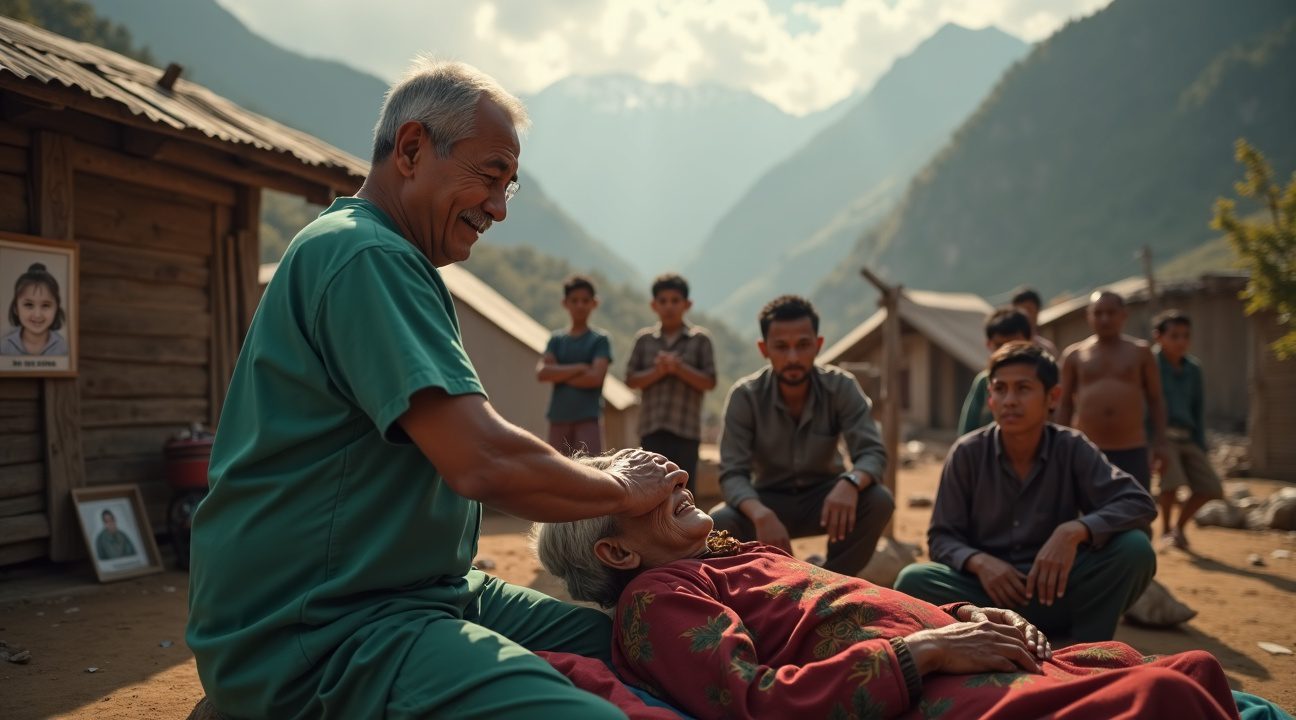Dr. Sanduk Ruit, famously known as the “God of Sight,” has profoundly impacted lives by restoring vision to over 100,000 people through free cataract surgeries, revolutionizing eye care accessibility in Nepal and globally.
Key Takeaways
- Dr. Ruit developed an economical cataract surgery method that uses $4 locally produced intraocular lenses instead of costly $200 imported ones—achieving high-quality outcomes at a fraction of the cost.
- His mobile eye camps reach the remotest Himalayan villages—many situated over 4,000 meters altitude—delivering transformative eye care to communities previously untouched by modern medicine.
- The Tilganga Institute of Ophthalmology performs around 2,500 surgeries weekly, with 40% conducted for free, showcasing a model of sustainable, high-volume humanitarian healthcare.
- His cost-effective surgical practices have been adopted globally in nations like Ethiopia, Cambodia, and Ghana, helping forge a self-sufficient network of affordable vision care efforts.
- A personal family tragedy—losing his sister to tuberculosis—inspires his mission, reinforcing his belief that poverty should never dictate access to life-saving healthcare.
Transforming Vision, Transforming Lives
The Nepalese surgeon has radically changed how health systems tackle vision loss in underserved regions. His innovation, Small-Incision Cataract Surgery (SICS), reduces procedure time to only five minutes while preserving excellent clinical results.
By manufacturing lenses locally at just $4—a significant contrast to the $200 foreign alternatives—Dr. Ruit’s approach not only reduces costs but also ensures scalability for nations lacking robust healthcare infrastructure.
Eye Camps in Himalayan Terrain
Dr. Ruit’s mobile surgical units make regular expeditions to Nepal’s most isolated locations. Villages where blindness was once accepted as irreversible now receive professional-grade eye treatment—even without stable electricity or traditional hospital settings. Despite these logistical challenges, outcomes often rival those in first-world surgical centers.
Tilganga Institute: A Model of Sustainability
The Tilganga Institute of Ophthalmology exemplifies high-efficiency, high-quality healthcare that remains economically viable. Patients who can afford to pay subsidize surgeries for those who cannot, making continuous charity unnecessary while still fulfilling a humanitarian mission.
Global Reach Through Training and Education
Dr. Ruit’s influence spreads through international training programs that teach surgeons both his surgical method and the associated low-cost healthcare model. This initiative reduces reliance on foreign aid and medical imports, empowering local practitioners in numerous developing countries.
Driven by Loss, Guided by Compassion
The death of Dr. Ruit’s sister from treatable tuberculosis in his childhood home served as the catalyst for his unwavering commitment. Her loss cemented his resolve to remove financial and geographic barriers from healthcare access, believing that no one should suffer due to where they are born or how much they earn.
Ripple Effects of Sight Restoration
The benefits of Ruit’s surgeries extend well beyond individual recipients. Restored eyesight allows people to return to the workforce, care for children, and support their communities. As individuals regain their independence, entire villages undergo socioeconomic transformation, illustrating how a single doctor’s technique can uplift thousands.
The “God of Sight” Who Changed Lives Through Revolutionary Medicine
Dr. Sanduk Ruit has earned his title as the “God of Sight” through an extraordinary mission that’s transformed over 100,000 lives across the globe. This remarkable eye surgeon from Nepal has dedicated his career to eliminating avoidable blindness, particularly in remote and underserved communities where medical care remains virtually inaccessible.
Ruit’s approach to vision restoration extends far beyond traditional medical practice. He’s developed innovative surgical techniques that make cataract surgery both affordable and effective, even in challenging environments lacking modern infrastructure. His work demonstrates how one person’s commitment can create ripple effects that reach communities across multiple continents.
Pioneering Free Eye Surgery in Remote Communities
The impact of Ruit’s free eye surgery initiatives reaches people who would otherwise never receive treatment. His mobile surgical camps bring advanced medical care directly to villages where patients have lived with preventable blindness for years. These expeditions often involve traveling through difficult terrain and working in makeshift surgical facilities, yet Ruit maintains the same high standards he’d uphold in any modern hospital.
His revolutionary techniques for cataract surgery have made procedures faster and more cost-effective without compromising safety or outcomes. This efficiency allows him to treat hundreds of patients during each mission, dramatically increasing the number of people who can benefit from his expertise. The surgeon’s methods have been adopted by medical professionals worldwide, multiplying his impact beyond his direct patient interactions.
Global Recognition and Sustainable Impact
International recognition of Ruit’s work has opened doors for expanding his mission’s reach. His achievements have attracted support from various organizations and philanthropists who recognize the value of his approach to treating avoidable blindness. This support system enables him to train other surgeons in his techniques, creating a sustainable network of vision restoration specialists.
The training programs Ruit has established ensure his methods continue benefiting communities long after his initial visits. Local surgeons learn his innovative approaches, allowing them to provide ongoing care in their regions. This knowledge transfer creates lasting change that doesn’t depend solely on Ruit’s physical presence in each community.
Contemporary initiatives like Mr. Beast’s vision restoration project have brought renewed attention to the importance of addressing preventable blindness worldwide. Such efforts highlight how individual dedication to helping others can inspire broader movements and attract additional resources for tackling global health challenges.
Ruit’s legacy extends beyond the impressive statistics of surgeries performed. His work has proven that innovative medical solutions combined with genuine compassion can overcome seemingly impossible barriers to healthcare access.
https://www.youtube.com/watch?v=4WcFa1x3O8M

How a $4 Innovation Rivals $3,000 Western Surgeries
Dr. Ruit’s groundbreaking approach centers on Small-Incision Cataract Surgery (SICS), a technique he perfected alongside his Australian partner Fred Hollows. This revolutionary method transforms cataract treatment by making it accessible to millions who previously couldn’t afford sight-restoring surgery.
The financial breakthrough lies in locally produced intraocular lenses that cost as little as $4 each, dramatically undercutting the $200 price tag of imported alternatives. Manufacturing these lenses within Nepal eliminates the supply chain costs and import duties that traditionally inflate medical equipment prices in developing countries.
Superior Outcomes at Fraction of the Cost
SICS delivers remarkable results that challenge assumptions about expensive medical care. The sutureless technique achieves 20/40 vision or better in 87% of cases, matching or exceeding outcomes from Western surgeries that cost over $3,000. These statistics demonstrate that innovative approaches can deliver high-quality low-cost surgery without compromising patient outcomes.
The sutureless cataract surgery method reduces complications and accelerates recovery times compared to traditional techniques. Patients experience minimal discomfort and can return to their daily activities within days rather than weeks. This efficiency proves particularly valuable in rural areas where patients travel long distances for treatment and can’t afford extended recovery periods.
Fred Hollows’ partnership brought crucial technical expertise and international credibility to the project. His foundation helped establish lens manufacturing facilities that maintain strict quality standards while keeping costs minimal. The collaboration created a sustainable model that continues operating independently, producing thousands of lenses monthly for regional distribution.
The $4 lens represents more than cost reduction—it symbolizes a complete reimagining of medical economics. By proving that essential medical devices can be manufactured affordably without sacrificing quality, this innovation challenges the entire global medical supply chain. Similar to how philanthropic efforts restore sight through various approaches, Dr. Ruit’s work demonstrates multiple pathways to addressing blindness.
Local production creates additional benefits beyond cost savings:
- Manufacturing facilities provide employment opportunities in underserved regions.
- Technical expertise develops within local communities.
- This approach ensures long-term sustainability rather than dependence on foreign aid or charity.
The technique’s simplicity makes it teachable to surgeons across different skill levels and resource environments. Dr. Ruit has trained hundreds of surgeons throughout Asia and Africa, multiplying the impact of his innovation. Each trained surgeon can perform thousands of surgeries annually, creating a cascading effect that reaches remote communities previously without access to eye care.
Quality control measures ensure the $4 lenses meet international standards despite their low cost. Regular testing and certification processes maintain consistency across production batches. Independent studies confirm that these affordable lenses perform identically to expensive imported versions in terms of clarity, durability, and biocompatibility.
The success of SICS challenges conventional wisdom about medical innovation requiring massive research budgets and complex technologies. Sometimes the most effective solutions emerge from understanding local needs and constraints rather than applying expensive Western medical models. This approach has inspired similar innovations in other medical fields, demonstrating how creativity and determination can overcome resource limitations.
Dr. Ruit’s model proves that exceptional surgical outcomes don’t require expensive equipment or facilities. His technique works effectively in basic surgical environments, making it adaptable to rural clinics and temporary surgical camps. This flexibility allows eye care to reach patients who would never access traditional hospital-based surgery.
The ripple effects extend beyond individual patients to entire communities. Restored vision enables people to return to work, care for families, and contribute economically to their societies. These broader impacts justify the investment in affordable eye care programs and demonstrate how medical innovation can drive social and economic development.
Trekking to Himalayan Villages Where No Doctor Has Gone Before
Dr. Ruit’s commitment to bringing vision care to Nepal’s most isolated communities takes him far beyond the comfort of modern medical facilities. His expeditions into the Himalayas represent some of the most challenging medical missions on Earth, where altitude sickness threatens both doctor and patient alike.
High-Altitude Medical Missions in Extreme Conditions
At 4,345 meters above sea level, Dolpo stands as one of the most remote regions Dr. Ruit regularly visits. The journey itself becomes a medical challenge, with oxygen levels dropping to roughly half of what’s available at sea level. Despite these harsh conditions, Dr. Ruit and his dedicated team push forward, carrying surgical equipment and supplies across treacherous mountain passes where landslides and sub-zero temperatures create constant danger.
These Himalayan outreach missions aren’t sporadic events—they’re carefully planned operations that coincide with local festivals and gatherings. During the recent Shey Festival in Dolpo, Dr. Ruit’s team examined over 1,200 villagers and successfully performed 98 surgeries. The timing proves crucial, as festivals bring scattered mountain communities together, maximizing the number of people who can receive care during a single expedition.
Mobile Eye Camps Transforming Rural Healthcare
The mobile eye camp model Dr. Ruit has perfected addresses the stark reality of healthcare inequality in mountainous regions. Many villagers he treats have never seen a doctor in their entire lives, let alone an eye specialist. His screening process identifies patients with cataracts, glaucoma, and other treatable conditions that have left them functionally blind for years.
Each mobile eye camp follows a systematic approach that includes:
- Mass screenings using portable equipment designed for high-altitude conditions
- Priority assessment for patients with the greatest potential for vision restoration
- Same-day surgeries performed in temporary operating theaters
- Post-operative care instructions delivered in local dialects
- Follow-up protocols adapted for patients who may live days away from any medical facility
The success of these missions extends beyond individual surgeries. Dr. Ruit trains local health workers during each visit, building sustainable healthcare capacity in marginalized communities. His approach recognizes that one-time interventions, while valuable, can’t address the ongoing need for eye care in rural Nepal.
Weather windows often dictate the timing of these expeditions, with monsoon seasons and winter storms making mountain travel impossible for months at a time. Dr. Ruit has learned to work within these natural constraints, sometimes racing against approaching weather systems to complete surgeries before conditions deteriorate.
The physical demands of high-altitude surgery challenge even experienced medical professionals. Reduced oxygen levels affect fine motor control and decision-making, requiring Dr. Ruit to adapt his surgical techniques for mountain conditions. His team carries supplemental oxygen and altitude sickness medications, understanding that their own health directly impacts patient outcomes.
These Himalayan missions have restored sight to thousands of people who would otherwise remain blind for life. Patients often travel for days on foot just to reach the temporary clinics, bringing their entire families to witness what many consider miraculous transformations. The emotional impact of these surgeries resonates throughout entire villages, as restored vision means renewed independence and economic opportunity.
Dr. Ruit’s work in places like Dolpo demonstrates how modern medicine can reach the world’s most isolated populations when practitioners are willing to embrace extreme challenges. His model has inspired similar initiatives globally, proving that geographic barriers don’t have to mean permanent blindness. The success of these mobile eye camps shows that innovative healthcare delivery can bridge the gap between urban medical centers and rural communities that traditional healthcare systems have left behind.
Similar efforts to restore vision have gained international attention, including initiatives by content creators helping people regain their sight, highlighting the global importance of accessible eye care.
https://www.youtube.com/watch?v=V2BHEZ6AF6M

From Nepal to the World: How One Institute Performs 2,500 Surgeries Weekly
The Tilganga Institute of Ophthalmology stands as a beacon of medical innovation in Kathmandu, where Dr. Ruit’s vision transformed into a global movement. I’ve observed how this remarkable institution now conducts up to 2,500 surgeries weekly, demonstrating that high-volume, high-quality eye care can exist without compromising accessibility. The institute’s commitment runs deeper than numbers—40% of these procedures are provided completely free to the poorest patients, ensuring that economic barriers don’t prevent sight restoration.
Breaking Global Monopolies Through Local Innovation
Dr. Ruit’s most revolutionary achievement lies in disrupting the established medical supply chain. Previously, intraocular lenses carried a hefty $200 price tag, controlled by major manufacturers who maintained strict monopolies. The institute changed everything by developing local lens manufacturing capabilities, slashing costs by an astounding 98%. This dramatic cost reduction didn’t sacrifice quality—these locally produced lenses meet international standards while remaining accessible to patients across economic spectrums.
The ripple effects of this innovation extend far beyond Nepal’s borders. Ethiopia now treats 50,000 patients annually using Dr. Ruit’s proven protocols, while similar programs have taken root from Cambodia to Ghana. Each adaptation demonstrates how sustainable blindness eradication becomes achievable when communities can manufacture their own medical supplies rather than relying on expensive imports.
A Global Template for Medical Accessibility
The success stories emerging from various countries prove that Dr. Ruit’s model works across different healthcare systems and economic conditions. Other philanthropic initiatives have also recognized the power of restoring sight, showing how this approach inspires action worldwide. Countries implementing these protocols discover that local manufacturing capabilities create self-sustaining programs rather than temporary relief efforts.
The Tilganga Institute serves as more than just a medical facility—it functions as a training center where ophthalmologists from developing nations learn both surgical techniques and sustainable business models. This knowledge transfer ensures that each participating country can eventually operate independently, creating a network of interconnected programs that support global eye health initiatives.
The institute’s weekly surgery volume of 2,500 procedures represents more than statistical achievement; it demonstrates how proper resource allocation and innovative thinking can multiply impact exponentially. Dr. Ruit’s approach proves that addressing global health challenges requires both medical expertise and entrepreneurial solutions that make treatments permanently accessible to those who need them most.
https://www.youtube.com/watch?v=3z0gkpN_bKc
Global Recognition for a Humanitarian Vision
Dr. Ruit’s extraordinary contributions to global eye health have earned him widespread international acclaim and prestigious honors that recognize both his medical innovations and humanitarian impact. His work has transcended geographical boundaries, establishing him as a leading figure in the fight against preventable blindness worldwide.
Prestigious International Awards
Among his most notable achievements, Dr. Ruit received the Ramon Magsaysay Award for Peace and International Understanding, often referred to as Asia’s Nobel Prize. This recognition highlighted his dedication to bringing sight to underserved populations across the developing world. More recently, he was honored with the 2025 Isa Award for Service to Humanity, which comes with a substantial $1 million prize, acknowledging his transformative impact on global health through accessible eye care.
These accolades represent more than personal recognition – they validate his approach to making high-quality medical care available to those who need it most, regardless of their economic circumstances. The international medical community has consistently praised his innovative techniques and commitment to training local surgeons in developing countries.
Academic and Professional Recognition
Dr. Ruit’s surgical techniques and methodologies have gained such respect that they’re now taught at some of the world’s most prestigious medical institutions, including Harvard Medical School. This integration into leading academic curricula demonstrates how his practical, cost-effective approaches have revolutionized modern cataract surgery on a global scale.
His influence extends beyond individual procedures to systemic change in how eye care is delivered in resource-limited settings. Medical professionals worldwide study his streamlined surgical protocols and community-based treatment models. Similar recognition has been given to other humanitarian efforts in healthcare, such as when MrBeast restored sight to 1000 individuals, highlighting the growing awareness of treatable blindness as a global issue.
The global recognition Dr. Ruit has received reflects not just his surgical skill, but his vision of making quality eye care a universal right rather than a privilege. His honors serve as a beacon for other medical professionals who seek to combine clinical excellence with humanitarian service, proving that one person’s dedication can truly change the world.
From Personal Tragedy to a Mission Against Poverty and Suffering
Dr. Sanduk Ruit’s extraordinary journey began in Olangchungola, one of Nepal’s most remote mountain villages, where the nearest road lay days away by foot. Born into a community where basic healthcare remained virtually inaccessible, his early life experiences would forge an unshakeable determination to transform the lives of those forgotten by modern medicine.
The defining moment that shaped Dr. Ruit’s mission came through devastating personal loss. His younger sister died from tuberculosis, a preventable and treatable disease, simply because proper medical care wasn’t available in their isolated region. This tragedy crystallized a profound truth that would drive his life’s work: poverty shouldn’t equate to suffering, especially when solutions exist within reach.
A Philosophy Born from Loss
The death of his sister didn’t just represent a family tragedy—it embodied the systematic failure that condemned millions to preventable blindness and death across developing nations. Dr. Ruit witnessed firsthand how geographical isolation and economic circumstances could determine whether someone lived or died, saw clearly or remained blind. This experience instilled in him a deep understanding that healthcare shouldn’t be a privilege reserved for the wealthy or those fortunate enough to live in urban centers.
His philosophy extends beyond simply providing medical care. Dr. Ruit believes that restoring sight represents one of the most powerful ways to break the cycle of poverty. When someone regains their vision, they can work again, support their families, and contribute to their communities. A single cataract surgery doesn’t just change one person’s life—it transforms entire households and communities.
This social mission drove Dr. Ruit to pursue medical training despite overwhelming obstacles. Growing up in extreme poverty, he understood that education was his only pathway to creating the change he desperately wanted to see. His determination led him from the mountains of Nepal to medical school in India, where he specialized in ophthalmology and began developing the techniques that would later restore sight to hundreds of thousands.
The inspiration Dr. Ruit draws from his sister’s memory fuels his relentless pursuit of making eye care accessible to everyone, regardless of their economic status or geographic location. He’s developed cost-effective surgical techniques and established training programs that enable local doctors to perform sight-restoring procedures in their own communities. This approach ensures sustainable healthcare delivery rather than temporary interventions.
Dr. Ruit’s work mirrors other impactful humanitarian efforts, such as recent initiatives that restore vision to those in need. His model demonstrates how personal tragedy can become the catalyst for extraordinary humanitarian achievements when combined with unwavering determination and innovative thinking.
The remote village of Olangchungola continues to influence Dr. Ruit’s approach to healthcare delivery. He understands that effective medical intervention must account for the realities of rural life—limited transportation, seasonal weather patterns, and economic constraints that prevent people from traveling to distant hospitals. His mobile eye camps bring advanced surgical care directly to remote communities, eliminating the barriers that once made treatment impossible.
Through decades of work, Dr. Ruit has proven that overcoming poverty-related suffering requires more than good intentions. It demands:
- Innovative solutions
- Sustainable systems
- A deep understanding of the communities being served
His sister’s death transformed from a source of grief into a powerful force for healing, demonstrating how personal tragedy can inspire extraordinary humanitarian achievement.
Dr. Ruit’s mission continues to expand, training new generations of eye surgeons and establishing sustainable eye care programs across Asia and Africa. His work stands as proof that one person’s determination to honor a profound loss can illuminate the lives of hundreds of thousands, turning darkness into sight and despair into hope.
https://www.youtube.com/watch?v=2l6VKd94ZW8

Sources:
The Logical Indian: “Meet Dr. Sanduk Ruit of Nepal: The Visionary Surgeon Who Restored Sight to Over 100,000 Lives Worldwide for Free”
Wikipedia: “Sanduk Ruit”
DW Documentary: “Nepal: A doctor helps the blind see”
YouTube: “Dr. Sanduk Ruit, an eye surgeon from Nepal, has restored …”


